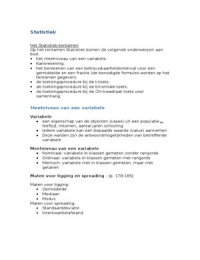Table of content
Chapter 1: Introduction to I/O Psychology 2
Chapter 2: Job analysis and evaluation 5
Chapter 4: Employee Selection: Recruiting and Interviewing 10
Chapter 5: Employee Selection: References and Testing 16
Chapter 6: Evaluating selection techniques and decisions 21
Chapter 7: Evaluating Employee Performance 25
Chapter 8: Designing and Evaluating Training Systems 30
Chapter 9: Employee Motivation 34
Chapter 10: Employee Satisfaction and Commitment 38
Chapter 15: Stress Management: Dealing with the Demands of Life and Work 44
1 of 47
,Summary Work psychology
Chapter 1: Introduction to I/O Psychology
Introduction
Industrial- • A branch of psychology that applies the principles of psychology to the workplace.
organizational • promoting and advancing understanding of individual, group and organizational effectiveness
psychology at work, and the well-being and satisfaction of people working in or served by
organizations
(Work Psychology)
• apply psychological theories to explain and enhance the effectiveness of human
behavior in the workplace
Applied Work Applying theories and methods of psychology to real-world problems
Psychology
Major fields of WP: • Personnel Psychology → recruitment, training employees, determining salary levels
(reflected the most in this course)
• Organizational Psychology → issues of leadership, job satisfaction, employee
motivation; groups of people; team work;…)
• Occupational Health and Safety (employee well-being; burn-out; safety procedures)
• Consumer Psychology (a bit untypical; close to economic psychology)
• Human Factors/Ergonomics → interaction between humans and machines; physical
fatigue and stress; e.g. how office space should be designed
• Coaching Psychology (close to clinical psychology; e.g. helping with high work
pressure)
Differences between • I/O:
I/0 and Business • examines factors that affect the people in an organization
programs: • relies on research, quantitative methods, testing techniques
• use empirical data and statistics to make decisions
• positive impacts on the lives of others (e.g. by increasing employee effectiveness)
• Business programs:
• examine areas as accounting, economics, marketing
Employment settings • Education
of I/P psychologists: • private/public sector
• consulting
• other
2 approaches to increase the productivity and well-being of employees:
1. The industrial approach:
• determining the competencies needed to perform a job
• staffing the organization with employees who have those competencies
• increasing these competencies through training
2. The organizational approach:
• creating an organizational structure and culture to motivate employees to perform well
• providing good and safe working conditions (work and life balance)
Ethics in I/O Psychology
• Type A = high levels of uncertainty as to what is right or wrong; there appears to be no best
solution, and there are both positive and negative consequences to a decision
• Type B (aka rationalizing dilemmas) = the difference between right and wrong is much clearer than
in a Type A dilemma. Usually, individuals know what is right but choose the solution that is the
most advantageous to themselves.
2 of 47
,Summary Work psychology
Brief history of I/O Psychology
early 1900s: • begin of I/O psychology → young discipline!
• the term „industrial psychology“ was seldom used prior to WWI
• Army Alpha → intelligence test developed during WWI and used by the army for soldiers
who can read
• Army Beta → intelligence developed during WWI and used by the army for soldiers who
cannot read
• Pioneers: Frank and Lillian Gilbreth: among the first to improve productivity and reduce
fatigue by studying the motions used by workers
1930: • Expansion from primarily personnel issues (e.g. selection) to improving the quality of the work
environment as well as the attitudes of employees
• The Hawthorne studies: Enhanced understanding of what motivates individuals in the
workplace. In addition to personal economic needs, social needs play an important role in
influencing work-related attitudes and behaviors.
• Hawthorne effect → Employees will perform better when they feel singled out for special
attention or feel that management is concerned about employee welfare.
1960s: Passage of several major pieces of civil rights legislation (e.g. fair selection techniques); use of
sensitivity training and T-groups (laboratory training groups)
1970s: greater understanding that involves employee satisfaction and motivation
1980s / 4 major changes:
1990s: 1. increased use of sophisticated statistical techniques and methods of analysis
2. application of cognitive psychology to industry (e.g. performance appraisal)
3. interest in the effects of work on family life and leisure activities
4. renewed interesting developing methods to select employees
2000s: • rapid advances in technology
• changing demographic makeup of the workforce → more diverse (women; minority groups,..)
• global economy is also affecting the role of I/O psychology
• factors currently impacting I/O psychology: e.g. high unemployment rates, family-friendly
work policies; flatter organizational structures
Research in Work Psychology
• Answering questions and making decisions
• Research and everyday life (therefore research here is very applied)
• therefore we need to be very realistic when designing
Scientist- • Acting as scientists when they conduct research and implementing these into the
Practitioner Model actual organizations as practitioners.
• → ultimate goal: application of evidence based management (instead of gut feeling)
„Common“ sense • One’s intuitions and beliefs about human behavior often turn out to be wrong.
• People have biases (overconfidence bias, self-serving bias, confirmation bias,
representativeness heuristic, narrative fallacy, …)
• → we cannot rely on common sense
• False beliefs (example): Lightning can strike twice at the same place
Research in WP • Decisions should be based on a combination of critical thinking and the best available
evidence (most of the time not the case; e.g. because it is cheaper; policies based on
nothing)
• Using data to drive decisions (better on the long-term)
3 of 47
,Summary Work psychology
Practical tips: • Demand evidence
• Stories are persuasive but more often inaccurate and data can be boring but is more
accurate so combine them
• Appreciate how little you know
Some key • Ideas/questions
concepts: • Hypotheses - well thought-out suggestions or ideas that can be tested
• Theories - systematic sets of assumptions regarding the nature and cause of particular events
The location of the • Laboratory research
study • 👍 Causal mechanisms/Control; Generalizability (Ext. validity)
• Field research
• 👍 realistic idea; 👎 : losing control (internal validity lost)
• „Real world“
→ No method is ideal
Participants in the • Employees → Preferred; but difficult to get access to them
study • Students → Generalizability?
• Sample size → Representative?
Cognitive biases
Anchoring bias • People are over-reliant on the first piece of information they hear.
• Example salary negotiation: whoever makes the first offer establishes several
reasonable possibilities in each person’s mind
Availability heuristic • People overestimate the importance of information that is available to them.
• Example: A person might argue that smoking is not unhealthy because they know
someone who lived to 100 and smoked three packs a day
Brandwagon effect • The probability of one person adopting a belief increases based on the number of
people who hold that belief.
• → Form of groupthink; reason why meetings are often unproductive
Blind-spot bias • Failing to recognize your own cognitive biases is a bias in itself.
• People notice cognitive and motivational biases much more in others
Choice-supportive bias • When you choose something, you tend to feel positive about it, even if that choice
has flaws.
• Example: Like how you think your dog is awesome - even if it bites people every
once in a while
Clustering illusion • This is the tendency to see patterns in random events.
• Example: It is key to various gambling fallacies, like the idea that red is more or less
likely to turn up on a roulette table after a string of reds
Confirmation bias • We tend to listen only to information that confirms our preconceptions - one of the
many reasons it’s so hard to have an intelligent conversation about climate change
Conservatism bias • Where people favor prior evidence over new evidence or information that has
emerged.
• Example: People were slow to accept that the Earth was round because they
maintained their earlier understanding that the plant was flat.
4 of 47
, Summary Work psychology
Chapter 2: Job analysis and evaluation
Job analysis = Gathering and analyzing information about the work an employee performs, the
conditions under which the work is performed, and the worker characteristics needed to perform the
work under the identified conditions.
Job analysis importance
Writing job descriptions /
Employee selection ➔ helps to predetermine criteria before interviews (reduce biases)
Training ➔ helps to determine which trainings are needed (very popular & trendy)
Personpower Planning • important but seldom employed use of job analysis to determine worker
mobility within organization
• i.e. if individuals are hired for a particular job, to what other jobs can they
expect to eventually be promoted and become successful?
• Problem: This approach can result in the so-called Peter Principle*
Performance appraisal ➔ evaluate performance (➔ training?); salary or whether giving a
permanent contract
Job classification ➔ determine pay levels, transfers, promotions
Job evaluation ➔ determine the worth of a job
Job design • determine the optimal way in which a job should be performed
• e.g. eliminate unsafe motions resulting in higher productivity and less job
injuries
Compliance with legal guidelines ➔ to withstand legal scrutiny
Organizational analysis ➔ identifying certain problems within an organization
*Peter Principle = The idea that organizations tend to promote good employees until they reach the
level at which they are not competent - in other words: their highest level of incompetence. E.g. The
best salesperson promoted to a supervisor but in fact he is not good at this position.
Job description (= the written result of a job analysis)
• a relatively short summary of a job (2-5 pages) ➔ in industry often only 1 page long ☹
• BUT: To be of value, it must describe a job in enough detail that decisions about actives (e.g.
selection, training) can be made
• the better the job description the higher the chances to find the right person to do the job
• a good job description saves you a lot of money and time
• a job description should regularly be updated
• „and performs other job-related duties as assigned“ should be included
8 sections of the job description*
Job title • describes the nature of the job, its power and status level, and the
competencies needed to perform the job
• aids in employee selection and recruitment (e.g. applicants can determine
whether their skills match those requirements for the job)
• provide workers with some form of identity
• can affect perceptions of the status and worth of a job (e.g. when containing
gender-neutral titles; some authors question these gender effects)
5 of 47





